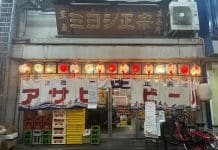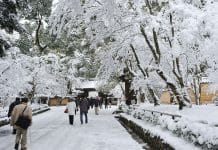New Battles Without Honor and Humanity: Last Days of the Boss (1976) is the last film in both Kinji Fukasaku’s gritty yakuza movie series Battles Without Honor and Humanity (1973 – 1974) and in his brief sequel series New Battles Without Honor and Humanity (1974 – 1976). All those films deal with violent battles between yakuza gangs; battles over status, territory, influence and of course, money.
At the same time, Last Days of the Boss is very much a stand-alone film with hardly any references to the previous entries into the series. It can easily be watched and understood without any knowledge of the previous Battle Without Honor and Humanity movies.

Let’s start with the story the film tells…
A drug addicted prostitute is found murdered in her room. Fingerprint checks by the police quickly point out the murderer: a member of Osaka’s Yonemoto Gumi, a yakuza group belonging to the much larger and very powerful Sakamoto Gumi, also based in Osaka. The murderer was thought to be her drug supplier and he may have killed her in a dispute over payments.
Two days later, police pull the corpse of the drug dealer out of a river. The suspicion for this second murder quickly falls on a low-ranking member of the Kawahara Gumi, an Amagasaki based yakuza outfit affiliated with the Genryukai, a yakuza network with its headquarters in Kitakyushu, Fukuoka Prefecture. That Kawahara Gumi member was the boyfriend of the prostitute, after all, revenge might have been his motivation for killing the drug pusher.
Were the police right in their assumptions? Perhaps, perhaps not. They got nothing on the Kawahara Gumi guy but their suspicions and have to let him go after questioning.
The rivalries between the Kawahara and Yonemoto groups however run deep. Though both murders are essentially minor issues in terms of yakuza politics, tempers are flaring, setting off a wave of violence.
Both groups are out for vengeance, bloody shoot-outs follow. As violent as it gets, it’s still a strictly local matter. Osaka on the one side, Amagasaki in Hyogo Prefecture on the other. The two cities are for the most part only separated by fairly narrow rivers.

Things get quickly out of hand and the real bosses become involved. The men around Hidematsu Sakamoto (Eitaro Ozawa), the leader of Sakamoto Gumi, decide to send a strong message to the leadership in Kitakyushu by killing one of their bosses.
They opt for Iwaki (Jun Tatara), the head of a yakuza outlet in Chikuho, Fukuoka Prefecture. Iwaki is not really one of the big-wigs, they figure but his killing would send the intended message.
Iwaki is however in a strong emotional father / son relationship with Shuichi Nozaki (Bunta Sugawara). After taking on Nozaki as an apprentice, Iwaki had prepared Nozaki to take over his position as local gang leader for a long time. Thus, Nozaki considers the killing of Iwaki as a very personal matter. He swears vengeance, no matter what.

The Genryukai bosses on the other hand clearly understand the message the Sakamoto Gumi intended to send with the murder of Iwaki: those stupid squabbles among those low-ranking members only lead to unnecessary trouble. There is money to be made and that should be the focus.

Both sides however underestimate Nozaki’s absolute determination to take revenge for Iwaki.
From then on, the focus of the movie switches from a depiction of misguided gang powerplays to a movie depicting Nozaki’s quest for revenge.
After an initial but failed attempt to have Yonemoto, the head of Yonemoto Gumi (Takuya Fujioka) killed by a hired Korean gangster named Joe (Eiji Go), Nozaki now goes for great leader Sakamoto himself.
Table of Contents
New Battles Without Honor and Humanity: Last Days of the Boss (Japan 1976) 新仁義なき戦い 組長最後の日
Disregarding the orders of the Genryukai bosses, Nozaki attacks the whole leadership of Sakamoto Gumi when they travel back to Osaka from the meeting in Kitakyushu in their small convoy of fancy cars, targeting leader Hidematsu Sakamoto specifically.

The resulting battle of Nozaki’s construction trucks attacking the Sakamoto Gumi limousines on a curvy seaside mountain road, presumably somewhere in Yamaguchi Prefecture, is clearly the highlight of the movie.
Dirty car crashes turn in an epic gun battle on that harrowing road, intensely shot by cameraman Toru Nakajima (who also did the camerawork on Kinji Fukasaku’s Violent Panic: The Big Crash, released in the same year 1976).

Sakamoto manages to escape the ambush. Undeterred, Nozaki follows Sakamoto to Osaka and eventually to Itami Airport…
Battles Without Honor and Humanity
The original Battles Without Honor and Humanity (Jingi Naki Tatakai) series (five films made in 1973 – 1974) proved to be the breakthrough for Kinji Fukasaku as movie director.
The series depicts yakuza gang wars in post WWII Hiroshima Prefecture and was based on actual events known as the Hiroshima Strife, a gang war lasting from 1950 to 1972.
Kozo Mino, one of the gang leaders involved wrote his memoirs while serving time in Abashiri Prison, Hokkaido. Those memoires appeared in re-written form as weekly installments in the magazine Shukan Sankei in the early 1970s.
Toei Studio got interested in the magazine article series early on and asked screen writer Kazuo Kasahara to turn some of the stories into screenplays. Kinji Fukasaku was the director chosen to realize the films.
The accounts written about the gang wars taking place in Hiroshima City proper turned out to be way too convoluted and too complicated. So, Kasahara focused on the stories taking place in Kure, a port town in Hiroshima. Those Kure stories could be shown on screen without the audience constantly asking “who is who?”.
Filming was done at Toei’s Kyoto studio and right on location in Kure, Hiroshima Prefecture. A large number of actual yakuza served as both extras and advisers, teaching the actors how to behave like a real yakuza.
Some of the gang leaders featured under a thin disguise (names and some circumstances changed) felt quite pleased by their portrayal while others became enraged and caused problems for Toei Studio.
The Battles Without Honor and Humanity series became an overwhelming success and profoundly changed the way yakuza movies were made. From ‘noble good guy beats bad guy’ morality plays, yakuza movies suddenly changed to morally ambiguous stories featuring violent mayhem as well as the intricate powerplays behind all that violence.
After the initial five films, Fukasaku considered moving on to new topics. The bosses at Toei however thought that the Hiroshima Strife could be milked for another couple million of Yen and persuaded Fukasaku to come up with more movies in the same vein, now under the title New Battles Without Honor and Humanity (Shin Jingi Naki Tatakai), resulting in three movies scripted by Koji Takada and directed by Kinji Fukasaku. Writer Takada met with various real yakuza leaders to enhance the realism of the movies.
New Battles Without Honor and Humanity: Last Days of the Boss (Shin Jingi Naki Tatakai: Kumicho Saigo no Hi) was the final entry in this series and it is the most fictional. Takada could simply let his imagination run wild without bothering much with any actual events.
Last Days of the Boss is also the only film in the whole series with a focus on Osaka.
The Director: Kinji Fukasaku
Kinji Fukasaku (1930 – 2003) worked in many different genres during his career though he is most commonly associated with gritty, bloody crime and yakuza movies. Fukasaku’s movies are, whatever the genre, extremely energetic and in the most cases, very violent.
Fukasaku was asked about the reasons for his use of extreme violence in his movies by many interviewers. He always responded by telling how he was working as 15 year old youth in an ammunition factory in the final days of World War II.
He was best friends with his co-workers, all of his age. They were a sworn-in group, in many cases knowing each other since their primary school days. The ammunition factory was frequently bombed in American air raids, many of his friends died right in front of him.
Depending on the interview, Fukasaku would go into quite graphic details.
The experience shaped his life and led him to strongly question authorities and governments throughout all of his film-making career. It was politicians, after all, that started World War II … while the bitter consequences were felt by teenage Fukasaku and his friends.
Bunta Sugawara

Bunta Sugawara (1933 – 2014) was one of the main yakuza movie actors of the 1970s. Unlike Ken Takakura, the other great yakuza actor of the era, Sugawara was ready to get deep into the dirty stuff, acting as a real bad guy while Takakura would insist on playing more honorable roles.
Sugawara, originating from Sendai in the north-east of Japan, moved to Tokyo after WW II and briefly studied law at Waseda University. He had to leave the school once he wasn’t able to afford the tuition. Sugawara turned to modeling, worked menial jobs in Tokyo and according to some sources, became a pimp.
Sugawara also tried his hand at acting for a number of film studios at the time but was deemed unsuitable by the studio heads.
His luck changed drastically once he was cast by Kinji Fukasaku for the 1972 yakuza thriller Street Mobster. Though too dark and violent for a success with mainstream audiences, Street Mobster was the starting point for a long collaboration between Fukasaku and Sugawara.
Sugawara, an intense actor with a real background living the hard life in post-war Tokyo, ready to do anything for the benefit of the movies in question, was the ideal actor for Fukasaku.
Fukasaku made Sugawara the main actor in all of his original Battle Without Honor and Humanity films, always playing the character of Shozo Hirono, a war veteran who is gradually climbing up the ranks in the yakuza world, despite all setbacks and all jail times.
Sugawara was also the main actor in all the three New Battle Without Honor and Humanity films.
Usually cast as the character who aspires to be the leader, in Last Days of the Boss he gets to play the one who is out to kill the boss, no matter what.
Osaka Locations
Osaka is clearly established as the home of both the Yonemoto and Sakamoto yakuza groups right at the beginning. Osaka police handle the first murders featured in the movies. Everyone speaks with a heavy Osaka dialect, Osaka police cars are frequently on display, an Osaka police station is attacked with bombs.

Once Kitakyushu is introduced to the movie, the city gets portrayed with sweeping shots and documentary-style subtitles pointing out the various locations.
Osaka doesn’t get this treatment and neither does neighboring Amagasaki. Fukasaku seems to take it for granted that everyone knows that those cities are definite yakuza breeding grounds and don’t need any further introduction.

Tsutenkaku Tower in Shin Sekai makes a brief night time appearance to make sure every viewer knows where the story is taking place at that moment but that’s about it for local Osaka landmarks.

The Osaka featured in the movie is a city of back streets, pachinko parlors and more or less seedy bars. A dirty city where gang-related violence can burst out into the open at any given moment.
The final scenes of the movie play out at Itami Airport. Osaka Itami Airport was the main international airport for the whole Kansai region until 1994 when newly constructed Kansai Airport, built on re-claimed land in Osaka Bay took over that position.





















